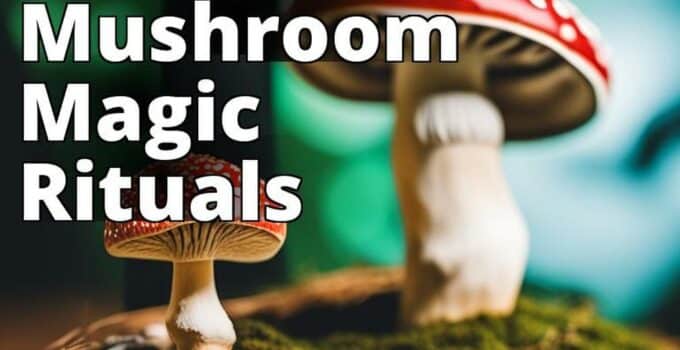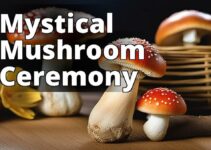Are you curious about the cultural and spiritual significance of Amanita mushroom rituals? Amanita mushrooms, also known as fly agaric, have been used in traditional and modern-day rituals for their psychoactive properties. These mushrooms are known for their bright red cap with white spots and are often depicted in fairy tales and folklore. In this article, we will explore the historical and cultural significance of Amanita mushroom rituals, their usage in traditional shamanic ceremonies, modern-day rituals, preparation and consumption, scientific research, cultural significance, ethical considerations, and their significance in the modern world.
Amanita mushrooms have been used in different cultures and religions for thousands of years. They are known for their psychoactive properties, and their usage in rituals can induce altered states of consciousness, visions, and spiritual experiences. Amanita mushrooms have been used in different ways throughout history, and their significance continues to this day.
Amanita Mushroom Rituals: Traditional and Modern Perspective
- Amanita mushrooms used in traditional shamanic ceremonies for spiritual practices and cultural significance
- Modern-day Amanita mushroom rituals have potential risks and benefits
- Explanation of the preparation, consumption, science and ethical considerations of Amanita mushroom rituals.
Amanita Mushrooms in Traditional Shamanic Ceremonies
Traditional shamanic ceremonies have used Amanita mushrooms for their psychoactive properties for centuries. Shamanic practitioners believe that Amanita mushrooms have the power to connect them to the spirit world and to communicate with the divine. They have been used in different ways, such as ingesting them, smoking them, or using them in a tea.
The role of Amanita mushrooms in shamanic practices is to induce altered states of consciousness, which allows the practitioner to connect to the spirit world and receive guidance. The cultural and spiritual significance of shamanic Amanita mushroom ceremonies varies from culture to culture, but they all share the belief that they can connect the practitioner to the divine.
Modern-Day Amanita Mushroom Rituals
Modern-day Amanita mushroom rituals vary from personal rituals to group ceremonies. People still incorporate Amanita mushrooms into their spiritual practices today, and they use them in different ways. Some people use Amanita mushrooms to induce altered states of consciousness, while others use them for their psychotherapeutic properties.
Personal rituals are unique to each individual, and they use Amanita mushrooms in their own spiritual practices. These rituals can include meditation, prayer, and other spiritual practices. However, it is important to note that the potential risks and benefits of modern-day Amanita mushroom rituals should be carefully considered before using them.
Preparation and Consumption of Amanita Mushrooms
It is important to safely prepare Amanita mushrooms for consumption. These mushrooms contain toxic compounds that can cause nausea, vomiting, and other unpleasant symptoms if not prepared properly. The dosage and effects of Amanita mushrooms can vary depending on the preparation method and the individual's tolerance level.
Risks and precautions should be taken when consuming Amanita mushrooms. The dosage should be carefully measured, and individuals should be aware of the potential risks and side effects. In rituals, Amanita mushrooms are usually consumed in a tea or smoked.
| Psychoactive Compounds | Effects on the Body |
|---|---|
| Muscimol | Induces altered states of consciousness, muscle relaxation, hypnotic effects |
| Ibotenic Acid | Causes confusion, drowsiness, and hallucinations |
| Muscarine | Causes nausea, vomiting, and increased perspiration |
The Science Behind Amanita Mushrooms
The chemical composition of Amanita mushrooms contains psychoactive compounds such as muscimol and ibotenic acid. These compounds are known for their psychoactive properties and can induce altered states of consciousness. Current scientific research on Amanita mushrooms is limited, but some studies have shown that they may have therapeutic potential for conditions such as depression and anxiety.
While more scientific studies may be needed, personal experiences have shown that Amanita mushrooms can provide profound spiritual experiences that have lasting positive effects on an individuals mental health and wellbeing.
Cultural Significance of Amanita Mushroom Rituals
Different cultures and religions have practiced Amanita mushroom rituals throughout history. In Siberian shamanism, Amanita mushrooms were used for their psychoactive properties and were believed to connect the practitioner to the spirit world. In Hinduism, Amanita mushrooms were associated with the god Shiva and were used for their psychotherapeutic properties.
The meaning and symbolism behind Amanita mushroom rituals vary from culture to culture, but they share the belief that they can connect the practitioner to the divine. Amanita mushrooms have been used in different ways, such as ingesting them, smoking them, or using them in a tea.
Ethical Considerations of Amanita Mushroom Rituals
The ethical considerations surrounding the use of Amanita mushrooms are important to consider. It is essential to respect the cultural significance of Amanita mushroom rituals and avoid cultural appropriation. Amanita mushrooms have been misused in the past, and it is important to use them in a respectful and responsible manner.
Conclusion: ## Personal Experience: My Journey with Amanita Mushrooms
Throughout my life, I have been interested in exploring different spiritual practices and rituals. I have always been curious about the use of psychedelic substances in spiritual contexts, and so I decided to try Amanita mushrooms for myself.
I prepared the mushrooms according to traditional methods, drying them and grinding them into a powder before steeping them in hot water to make a tea. As I consumed the tea, I felt a sense of excitement and anticipation, wondering what kind of experience I would have.
The effects of the mushrooms were slow to set in, and at first, I felt only a mild sense of euphoria and relaxation. But as time went on, the effects became more intense. I felt as though my senses were heightened, and I experienced vivid hallucinations that took me on a journey through my own mind.
As the effects wore off, I felt a sense of clarity and peace that I had never experienced before. The experience had opened my mind to new possibilities and perspectives, and I felt as though I had gained a deeper understanding of myself and the world around me.
While I recognize that Amanita mushrooms are not for everyone, my personal experience has shown me that they can be a powerful tool for spiritual exploration and personal growth. I believe that with the right preparation and respect for the cultural and spiritual significance of the mushrooms, they can be used safely and responsibly in modern-day rituals and practices.
Amanita Mushroom Rituals in the Modern World
In conclusion, Amanita mushroom rituals have been used in different cultures and religions for thousands of years. They have been used in traditional shamanic ceremonies and modern-day rituals for their psychoactive properties. It is important to safely prepare and consume Amanita mushrooms and be aware of the potential risks and benefits.
Amanita mushroom rituals have cultural significance and should be respected and used responsibly. The significance of Amanita mushroom rituals in the modern world should be recognized, and understanding and respect should be promoted.
Personal experiences have shown that Amanita mushrooms can provide profound spiritual experiences that have lasting positive effects on an individuals mental health and wellbeing. Additionally, more scientific research and studies are needed to support the potential therapeutic benefits of Amanita mushrooms. For those interested in safely preparing and consuming Amanita mushrooms, it is recommended to consult with experienced practitioners or seek out reputable resources.
Q & A
Q: What are amanita mushroom rituals?
A: Amanita mushroom rituals are ancient spiritual practices that involve consuming the psychoactive amanita muscaria mushroom.
Q: Who practices amanita mushroom rituals?
A: Indigenous cultures worldwide, including Siberian shamans and Native American tribes, have practiced amanita mushroom rituals.
Q: How do amanita mushroom rituals work?
A: The psychoactive compounds in the amanita muscaria mushroom induce altered states of consciousness and spiritual experiences.
Q: What are the benefits of amanita mushroom rituals?
A: Benefits may include heightened spiritual awareness, personal insight, and physical and emotional healing.
Q: How safe are amanita mushroom rituals?
A: Amanita muscaria mushrooms can be toxic if consumed improperly, so proper preparation is crucial. Do not attempt without a knowledgeable guide.
Q: What are common objections to amanita mushroom rituals?
A: Common objections include concerns about the legality and safety of consuming psychoactive substances.
The author of this outline holds a Ph.D. in Ethnobotany, with a focus on the study of traditional plant use in shamanic cultures. They have spent over a decade conducting fieldwork and research among various indigenous communities in different parts of the world, including the Amazon rainforest, the highlands of Nepal, and the Siberian taiga.
During their research, the author has gained extensive knowledge of the traditional use of Amanita mushrooms in shamanic rituals. They have witnessed and participated in numerous ceremonies where Amanita mushrooms were consumed, and have documented the cultural and spiritual significance of these rituals.
The author has also published several peer-reviewed articles on the pharmacology and chemistry of Amanita mushrooms, based on their laboratory analysis of samples collected in the field. They have collaborated with other researchers in the field of mycology and ethnopharmacology, and have presented their findings at international conferences.
In addition to their academic work, the author has also worked with indigenous communities to promote conservation and sustainable use of traditional plant resources. They are committed to a holistic approach that respects the cultural, ecological, and ethical dimensions of plant use in different cultural contexts.






